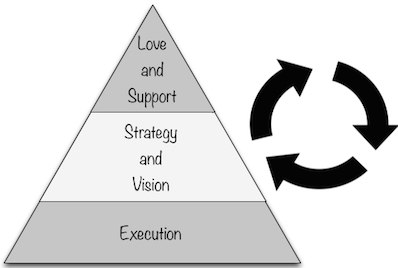16 9 / 2015
Building a great product? Start with execution

There are a number of beautiful products out there and each has its own story and is the result of some strong design principles. In the startup world there is a lot of talk about lean principles, and as I have been reading and practicing some of it myself, I wanted a more concise model that explains the path to a great product. I also wanted something simpler as a starter that could then lead to the discovery of processes and techniques to building wow products.
For me great products are a result of execution, strategy and vision, and love and support. I mentioned execution first which may seem counter intuitive in some ways - how can you execute without having a vision? Well, to be honest you cannot have a vision without having built something. You see great products explain themselves; the vision is so clear, so polished, so distilled, that it’s almost impossible to have this on day one. Sure you may have an idea of some target customer segment, some unfulfilled needs of your customers, and therefore the problem that your product needs to solve. But these only paint an outline of your product and in no way is representative of a vision that sets your product apart. You simply cannot have that clarity of thought to formulate a strategy on day one. Instead you must first invest in doing something and learning. This is execution.
As with any learning, you start with a vague idea of a subject and only through putting some of it in practice you learn more. As you peel back the layers, you get a more in-depth understanding of the industry, your customers, their problems, costs, compromises, existing solutions, substitutes, technology, restrictions, and so on. Not all of this will be known to you when you first start. But all of this knowledge needs to be distilled into your product to truly make it great. All great products started with some experimentation, may be as a side-project, or some scratching of an itch that then led to something bigger. Execute first and learn, and then hone your vision and strategy as you do this.
There is one another important element that goes into making great products, and this is love and support of employees, customers and product champions. Often this part is assumed and therefore not spoken of. But to me this plays a very crucial role in the process and needs to be understood. We live in the age of the long tail, so great products are not gems that get mined. Products that are lifted by the love of their customers turn great. Remember that love is also learning, so when your customers care they will tell you what can be done to improve, the areas where there needs to be more focus, and the features that can be cut off because they add minimal or no value. The learning you get through this love is like none other, it is not something you can simply learn by doing more things. You will not have this love on day one, it is built slowly over time, and so you cannot take it for granted.
Companies that build great products surround themselves with people who truly care. They place themselves in ecosystems that are supportive of new endeavours and grow through referrals to attract more of the same kind of people that already love them. Some move far and wide to places like Silicon Valley to give themselves that unfair advantage which comes with the support within that ecosystem, to accelerate their learning through it, and push their products to even greater heights. And there are techniques that can be adopted to earn this love, whether that is through offering stellar support or finding new ways to surprise and delight customers.

So this is my pyramid of great products: execution, vision and strategy, love and support. Each layer in the pyramid depends on the layer below it. There is a repeatable process that applies this pyramid, the cycle of execute, learn, plan, leveraging the love, and improving the execution that goes into building great products - I will leave that for a separate post. Right now, this is my pyramid, something that I find useful for myself and to explain to others who often get confused when starting with lean.